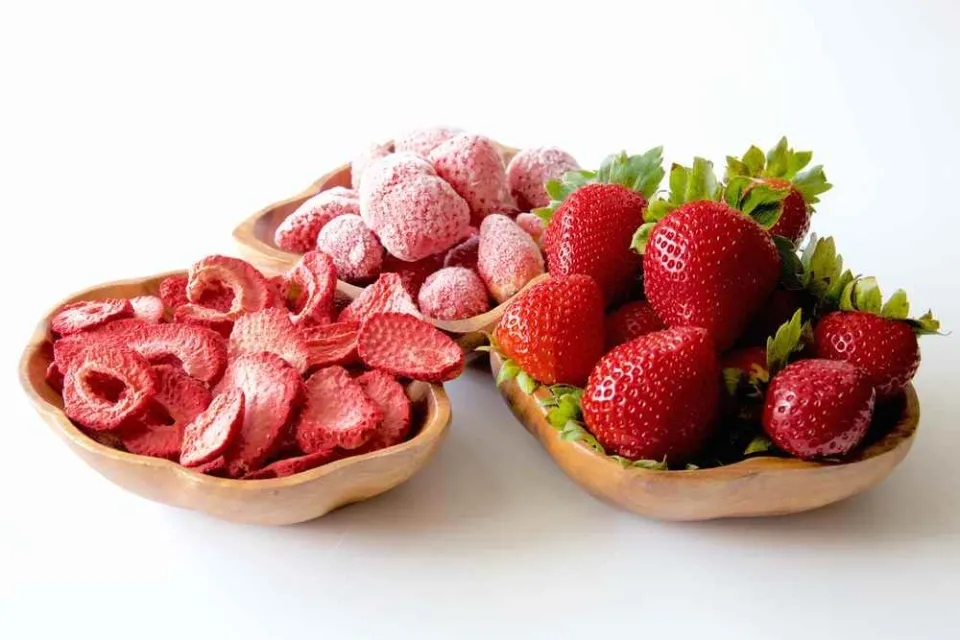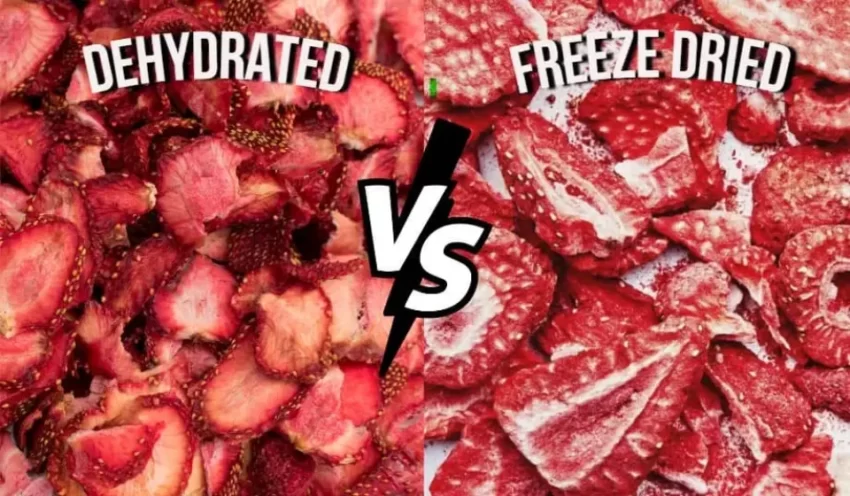There’s a common misconception that “dehydrated food” and “freeze-dried food” are the same, but they are not. Knowing the difference between freeze dry vs dehydrator helps when deciding how to store and preserve food for your family.
The fact that foods can be freeze-dried and dehydrated and then stored is one of their biggest advantages.
Does food that has been freeze-dried still taste and look the same after a while while maintaining its nutrition? Here is everything I have discovered through extensive research and extensive experience.
Table of Contents
What is Freeze-Drying?
Freeze-drying is a bit different than dehydrating. Instead of using heat, freeze-drying uses extremely cold temperatures (like -40 F), creates a vacuum around the food, and then alternately heats and cools the food to remove 99% of its moisture.
Due to this, the food can maintain a remarkable level of nutrient density and last up to 25 years on your shelf.
The drawback of freeze-drying is that you need a freeze-drying unit. The cost of these home models may be prohibitive, but we believe the value to be well worth it.
Related Post: Can You Freeze Dry Dog Food?
What is Dehydrating?
When you dehydrate you use warm blowing air to remove between 70-90% of the moisture out of the food. This implies that since there isn’t any moisture present, there won’t be any bacterial growth or mold and the food will be shelf-stable.
Depending on how much moisture you have removed from the food, dehydrated foods can typically be kept on your shelf for about a year.
It’s very simple to get started with dehydrating because you can use a dehydrator, a warm, sunny day, or even a low temperature in your oven.
Also Read: Best Dehydrator For Jerky
What’s the Difference Between Freeze Drying and Dehydrating?

The major difference between freeze-drying and dehydrating is this: Compared to dehydrating products, freeze-dried food has a longer shelf life.
This is due to the fact that 98 percent of the water in food is removed during the freeze-drying process. The food is covered in ice crystals using a sizable freezer to accomplish this. Then, the food is vacuum-sealed very slowly by evaporating the existing water for optimal freshness.
Dehydrating foods, however, removes only about 80 percent of the water, and typically does not involve vacuum-seal technology, (And ICYMI, according to Gans, the presence of water is what causes food to become contaminated with bacteria, mold, and decomposition.)
According to Gans, food is typically dehydrated in the sun or through air drying, but there are also dehydration appliances like ovens that draw moisture from food by circulating air at extremely high temperatures.
Although there is typically a textural difference as well, both techniques have the tendency to slightly alter food’s natural flavor. According to Gans, freeze-drying is the better technique for preserving a food’s natural flavor and odor.
Why You Should Choose Freeze Drying?
Variety is arguably the best justification for freeze-drying. For preservation and food storage, virtually any food can be freeze dried. Meats, fruits, vegetables, desserts, even complete meals. Furthermore, the rehydration time for freeze-dried foods like meals, meats, dairy, eggs, and vegetables is quick, sometimes even instant.
Sour cream can also be kept without refrigeration and can be frozen along with dry cottage cheese. cheesy scrambled eggs? No issue, the best method for preserving and storing dairy products and eggs is freeze drying. However, it is very challenging to dehydrate these foods.
Preservation of leftovers and ripening fruits and vegetables starts to feel important when you consider that almost 40% of the food that families buy is wasted. There are many reasons why people discard food. Families frequently make or purchase too much food at first, forget to reheat leftovers, or simply put food on the counter or in the back of the refrigerator until it spoils.
Families can save time and money by using a home freeze dryer to quickly and easily solve these issues. All of your food that is ripening and leftovers can now be preserved.
Foods that have been freeze-dried have a longer shelf life, less moisture, and generally better flavor than foods that have been dehydrated. Foods that have been freeze-dried rehydrate more quickly while keeping their original form, texture, and color.
Foods can be freeze dried in a much wider variety than they can be dehydrated. Consider attempting to preserve cheese, an ice cream sandwich, or a raw egg with a home dehydrator. The plan would utterly fail. if freeze-dried, not so.
Read More: How to Freeze-Dry Meat?
Final Words on Freeze Dry Vs Dehydrator
In conclusion, freeze-dried foods generally taste better than dehydrated foods and have a longer shelf life. They also contain less moisture.
Foods that have been freeze-dried rehydrate more quickly while keeping their original form, texture, and color. Foods can be freeze dried in a much wider variety than they can be dehydrated.
FAQs
Is a Freeze Dryer the Same as a Dehydrator?
Freeze-drying is a bit different than dehydrating. Instead of using heat, freeze-drying uses extremely cold temperatures (like -40 F), creates a vacuum around the food, and then alternately heats and cools the food to remove 99% of its moisture.
Which is Healthier Freeze-dried Or Dehydrated?
Freeze-dried foods retain the vast majority of the vitamins and minerals found in their original state. Freeze-dried food retains its nutrition because of the “cold, vacuum” process that is used to extract the water.
Can You Freeze Dry in An Air Fryer?
The properties of an air fryer make it impossible to use to make freeze-dried foods. Since they can’t freeze anything, air fryers use extremely hot air to cook food.

